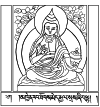 Shantideva on Solitude
Shantideva on Solitude
The Bodhicarydvatara of Shantideva, the 8th century student of Nagarjuna, is usually translated as "the way" or "the path" of the Bodhisattva. "Bodhisattva" means "enlightenment being." Hence a Bodhisattva is a follower of the Buddhist way or path toward enlightenment, which could generically refer to any Buddhist. This point is relevvant because Western sources typically extract the concept of compassion or loving-kindness as the essential teaching of the Bodhicarydvatara but do so without the "way" or "path" prescribed by Shantideva.
A close reading of Shantideva shows that the entire path is a prerequisite to enlightenment, and that the path consists of solitude, the eremitic path. This point becomes clear after Shantideva's long presentation of Buddhist philosophical principles culminates in methodology. Chapter 8, titled "Meditation," explicitly states that the first step is to "cultivate diligence" and "set the mind to concentration."
In solitude, the mind and
body
Are untroubled, without distraction.
Therefore, leave this worldly life
And totally abandon mental wandering (8, 2).
This comportment is based philosophically on the transcience of all things: people, relations, possessions, and emotions. Understanding this, the aspirant can understand the need to leave off craving and desire, the plaudits of the world. The next step is unambiguous:
In forests, haunts of stag
and bird,
Among the trees, no discord rises,
It is here where I would keep pleasant company!
When shall I make my dwelling there? (8, 25)
Here Shantideva evokes a tradition preceding Buddhism, namely the forest hermit of classical Hinduism. Such an evocation more strongly resonates with a universal eremitism common to India (and easily extrapolated) than with a strictly sectarian Tibetan Mahayana. Succeeding stanzas of the Bodhicarydvatara refer to a cave or deserted temple or a large tree as dwelling places owned by no one or unclaimed, as right dwelling places. He speaks of a new and free life with "just a begging bowl and a few posessions," dressed in ragged garments. Shantideva even refers to the frequenting charnal grounds, a favorite image of ascetic India. But it is the forest that most compels him.
So, let me live in solitude
In lovely, delightful forests,
With little trouble, with happiness and well-being,
Free from all distractions (8, 38).
The chapter reflects on the sources of transience, to the repulsiveness of lust and desire, before returning to the positive images of the path that lies before the narrator.
Let us now rejoice in
solitude,
In places where all strife and conflict have ceased,
In the peace and stillness of the forests (8, 85).
Again evolking the images of potential dwelling places -- abandoned stone temples and houses, caves, beneath trees -- Shantideva conludes the passages:
To have such liberty
unmarred by craving;
Loosened from every bond and tie;
A life of such contentment and such bliss,
Even the gods like Indra would be hard-pressed to find! (2, 88)
Reflecting thusly on the excellence of solitude,
completely stilling all discursiveness
Cultivate the mind of bodhichitta (2, 89).
The reference to "gods like Indra" underscores the cultural affinity of Shantideva to his contemporary spiritual milieu.
The rest of the book pursues the theme that the narrator, once quieting the mind, can insightfully realize that everyone, all persons, suffer as he did, and that are in need of help. As a forest hermit, however, he will not necessarily be a teacher like the Buddha but simply an example and source of spiritual energy for the enlightenment of all.
The practice of the enlightened being, therefore, is not based on advocating an abstract virtue or in attempting to conform to this virtue based on a theory or belief. Continuing the traditions of the East, Shantideva clearly indicates that virtue is a product or result, of solitude, disengagement, and meditation, not of an idea, goal, belief, tenet, or wish. Enlightenment is not advocated but is reflected in a total life path or way. No shortcuts can preempt the deliberate and conscious process that Shantideva outlines in the Bodhicarydvatara.
¶BIBLIOGRAPHICAL REFERENCES
Guide to the Bodhisattva's Way of Life: A Buddhist Poem for Today – How to Enjoy a Life of Great Meaning and Altruism, translated by Neil Elliott and Geshe Kelsang Gyatso. Glen Spey, NY: Tharpa Publications, 2002. The Way of the Bodhisattva, translated from the Tibetan by the Padmakara Translation Group. Boston: Shambhala, 2003; Engaging in Bodhisattva Behavior, translated from the Tibetan, as clarified by the Sanskrit, by Alexander Berzin, 2004 (http://www.berzinarchives.com/web/x/nav/group.html_1487505749.html).
